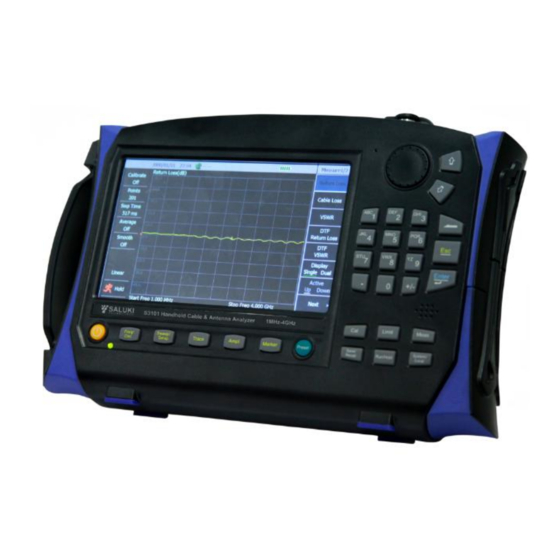
Table of Contents
Advertisement
Quick Links
Advertisement
Table of Contents

Summarization of Contents
Introduction and Overview
Guide Structure and Purpose
Outlines the guide's structure, covering readiness, applications, and help sections for the analyzer.
Instrument Setup and Operation
Pre-operation Preparation
Describes precautions before initial use, including safety instructions and warnings.
Environmental and Power Requirements
Specifies operating conditions, power supply methods, ESD precautions, and battery requirements.
Startup and Interface Overview
Explains powering on, front panel layout, operating interface, and top panel details.
Instrument Interfaces and Ports
Details the power, digital (SD, LAN, USB), and test ports on the analyzer for connectivity.
Battery Management and Powering On/Off
Covers battery installation, operation, charging, and instrument power cycling procedures.
Measurement Applications
3.1. Calibration
Explains the mechanical calibration method and steps for ensuring accurate test results.
3.2. Cable Test
Details testing return loss, VSWR, cable loss, and DTF measurements on cables.
3.3. Antenna Test
Describes testing the return loss/VSWR of passive receiving antennas.
3.4. Universal Devices and Parts Test
Explains testing attenuation, cable connectors, and cable joints using return loss.
Advanced Test Skills
Amplitude Adjustment
Describes methods for adjusting the amplitude display for clearer observation of curves.
Limit Line Function
Covers setting limit lines for batch testing to judge product qualification.
Alarm Function
Details the alarm function for indicating when a test curve exceeds the set limit line.
Data Management and Cable Models
Details storing/recalling data and selecting cable models for automated parameter matching.
DTF Measurement Parameters
Discusses factors affecting DTF measurement distance and resolution based on sweep parameters.
Troubleshooting and Support
Basic Troubleshooting Checks
Provides guidance for self-checking common problems with the analyzer before contacting support.
Error Log and Contact Information
Explains the "Error log" function for analyzing failures and provides contact details.
Repair and Packaging Procedure
Outlines steps for safely packaging the instrument for return-to-factory repair.















Need help?
Do you have a question about the S3101A and is the answer not in the manual?
Questions and answers